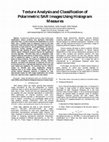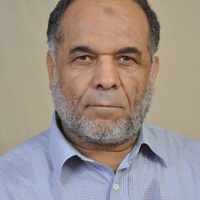Papers by Sachin Kumar Sengar

Advances in Intelligent and Soft Computing, 2012
ABSTRACT The Honshu, Japan earthquake of 11th March 2011, caused severe ha-zard in Japan and neig... more ABSTRACT The Honshu, Japan earthquake of 11th March 2011, caused severe ha-zard in Japan and neighboring countries. It revealed the need and importance of warning system for Tsunami generation to minimize the casualties. Seismograms of the Honshu earthquake event (recorded by broadband seismograms, being op-erated in the NW Himalaya by Wadia Institute of Himalayan Geology, Dehradun) are used for quick prediction of tsunami. The frequency content of these seismo-grams is studied and energy content in high frequencies is calculated, which is used to give tsunami warning. It is observed that wavelet coefficients for frequen-cies greater than 0.33 Hz tsunamigenic earthquakes do not show significant energy in the spectrum. However, significant energy is found in wavelet spectrum of non-tsunamigenic earthquake. In this paper we present the wavelet analysis on the Honshu, Japan earthquake of 11th March, 2011. Some other global tsunamigenic and non-tsunamigenic events are also analyzed for test and comparison purpose of the methodology used.

2015 2nd International Conference on Signal Processing and Integrated Networks (SPIN), 2015
ABSTRACT In polarized synthetic aperture radar (SAR) image classification, texture produces very ... more ABSTRACT In polarized synthetic aperture radar (SAR) image classification, texture produces very significant information about land cover. In order to perform the classification in a much better way, a detailed study of histogram measures has been performed. Good accuracies show that histogram measures are used which are best suited for several applications like land use monitoring, surface topology, crustal change, agricultural monitoring, map updating of urban areas, medical field and military system. Histogram measures improve the classification accuracy desirably. PALSAR data, that is unclassified radar images of different polarizations, of Solani River, Roorkee, India and its neighboring regions, is used for classifying the image based on texture features. The textures of images are found on the basis of histogram measures (mean, variance, standard deviation, correlation and skewness). As observed, the area can be characterized into a well-planned dispersed urban area with water bodies and vegetation. The accuracies vary for different classes. For efficient land cover classification, histogram measures have to be chosen suitably. Therefore, the role of various textural histogram measures is analyzed for their discriminative ability for SAR image classification into various land cover types like urban, vegetation and water bodies.
In this paper, we have presented the concept of wireless transmission i.e. power transmission wit... more In this paper, we have presented the concept of wireless transmission i.e. power transmission without using any type of the electrical conductor and/or wires. We have presented an idea that is discussed here about how electrical energy can be transmitted as microwaves so that to reduce the transmission, allocation and other types of losses. Such technique is known as Microwave Power Transmission (MPT). We have also presented and correlated several aspects with the currently available Power transmission systems to the related history of wireless power transmission systems and also the related developmental changes. The basic design, merits and demerits, applications of Wireless Power Transmission are also discussed.

Advances in Intelligent and Soft Computing, 2012
The Honshu, Japan earthquake of 11th March 2011, caused severe hazard in Japan and neighboring co... more The Honshu, Japan earthquake of 11th March 2011, caused severe hazard in Japan and neighboring countries. It revealed the need and importance of warning system for Tsunami generation to minimize the casualties. Seismograms of the Honshu earthquake event (recorded by broadband seismograms, being operated in the NW Himalaya by Wadia Institute of Himalayan Geology, Dehradun) are used for quick prediction of tsunami. The frequency content of these seismo- grams is studied and energy content in high frequencies is calculated, which is used to give tsunami warning. It is observed that wavelet coefficients for frequencies greater than 0.33 Hz tsunamigenic earthquakes do not show significant energy in the spectrum. However, significant energy is found in wavelet spectrum of non tsunamigenic earthquake. In this paper we present the wavelet analysis on the Honshu, Japan earthquake of 11th March, 2011. Some other global tsunamigenic and non-tsunamigenic events are also analyzed for test and comparison purpose of the methodology used.

In polarized synthetic aperture radar (SAR) image
classification, texture produces very significa... more In polarized synthetic aperture radar (SAR) image
classification, texture produces very significant information
about land cover. In order to perform the classification in a much
better way, a detailed study of histogram measures has been
performed. Good accuracies show that histogram measures are
used which are best suited for several applications like land use
monitoring, surface topology, crustal change, agricultural
monitoring, map updating of urban areas, medical field and
military system. Histogram measures improve the classification
accuracy desirably. PALSAR data, that is unclassified radar
images of different polarizations, of Solani River, Roorkee, India
and its neighboring regions, is used for classifying the image
based on texture features. The textures of images are found on
the basis of histogram measures (mean, variance, standard
deviation, correlation and skewness). As observed, the area can
be characterized into a well-planned dispersed urban area with
water bodies and vegetation. The accuracies vary for different
classes. For efficient land cover classification, histogram
measures have to be chosen suitably. Therefore, the role of
various textural histogram measures is analyzed for their
discriminative ability for SAR image classification into various
land cover types like urban, vegetation and water bodies.

The Honshu, Japan earthquake of 11th March 2011, caused severe hazard in Japan and neighboring co... more The Honshu, Japan earthquake of 11th March 2011, caused severe hazard in Japan and neighboring countries. It revealed the need and importance of warning system for Tsunami generation to minimize the casualties. Seismograms of the Honshu earthquake event (recorded by broadband seismograms, being operated in the NW Himalaya by Wadia Institute of Himalayan Geology, Dehradun) are used for quick prediction of tsunami. The frequency content of these seismo-
grams is studied and energy content in high frequencies is calculated, which is used to give tsunami warning. It is observed that wavelet coefficients for frequencies greater than 0.33 Hz tsunamigenic earthquakes do not show significant energy in the spectrum. However, significant energy is found in wavelet spectrum of non tsunamigenic earthquake. In this paper we present the wavelet analysis on the Honshu, Japan earthquake of 11th March, 2011. Some other global tsunamigenic and non-tsunamigenic events are also analyzed for test and comparison purpose of the methodology used.
In this paper, we have presented the concept of wireless trans-mission i.e. power transmission wi... more In this paper, we have presented the concept of wireless trans-mission i.e. power transmission without using any type of the
electrical conductor and/or wires. We have presented an idea
that is discussed here about how electrical energy can be ransmit-ted as microwaves so that to reduce the transmission, allocation and
other types of losses. Such technique is known as Microwave Power
Transmission (MPT). We have also presented and correlated several
aspects with the currently available Power transmission systems to
the related history of wireless power transmission systems and also
the related developmental changes. The basic design, merits and
demerits, applications of Wireless Power Transmission are also dis-
cussed.











Uploads
Papers by Sachin Kumar Sengar
classification, texture produces very significant information
about land cover. In order to perform the classification in a much
better way, a detailed study of histogram measures has been
performed. Good accuracies show that histogram measures are
used which are best suited for several applications like land use
monitoring, surface topology, crustal change, agricultural
monitoring, map updating of urban areas, medical field and
military system. Histogram measures improve the classification
accuracy desirably. PALSAR data, that is unclassified radar
images of different polarizations, of Solani River, Roorkee, India
and its neighboring regions, is used for classifying the image
based on texture features. The textures of images are found on
the basis of histogram measures (mean, variance, standard
deviation, correlation and skewness). As observed, the area can
be characterized into a well-planned dispersed urban area with
water bodies and vegetation. The accuracies vary for different
classes. For efficient land cover classification, histogram
measures have to be chosen suitably. Therefore, the role of
various textural histogram measures is analyzed for their
discriminative ability for SAR image classification into various
land cover types like urban, vegetation and water bodies.
grams is studied and energy content in high frequencies is calculated, which is used to give tsunami warning. It is observed that wavelet coefficients for frequencies greater than 0.33 Hz tsunamigenic earthquakes do not show significant energy in the spectrum. However, significant energy is found in wavelet spectrum of non tsunamigenic earthquake. In this paper we present the wavelet analysis on the Honshu, Japan earthquake of 11th March, 2011. Some other global tsunamigenic and non-tsunamigenic events are also analyzed for test and comparison purpose of the methodology used.
electrical conductor and/or wires. We have presented an idea
that is discussed here about how electrical energy can be ransmit-ted as microwaves so that to reduce the transmission, allocation and
other types of losses. Such technique is known as Microwave Power
Transmission (MPT). We have also presented and correlated several
aspects with the currently available Power transmission systems to
the related history of wireless power transmission systems and also
the related developmental changes. The basic design, merits and
demerits, applications of Wireless Power Transmission are also dis-
cussed.
classification, texture produces very significant information
about land cover. In order to perform the classification in a much
better way, a detailed study of histogram measures has been
performed. Good accuracies show that histogram measures are
used which are best suited for several applications like land use
monitoring, surface topology, crustal change, agricultural
monitoring, map updating of urban areas, medical field and
military system. Histogram measures improve the classification
accuracy desirably. PALSAR data, that is unclassified radar
images of different polarizations, of Solani River, Roorkee, India
and its neighboring regions, is used for classifying the image
based on texture features. The textures of images are found on
the basis of histogram measures (mean, variance, standard
deviation, correlation and skewness). As observed, the area can
be characterized into a well-planned dispersed urban area with
water bodies and vegetation. The accuracies vary for different
classes. For efficient land cover classification, histogram
measures have to be chosen suitably. Therefore, the role of
various textural histogram measures is analyzed for their
discriminative ability for SAR image classification into various
land cover types like urban, vegetation and water bodies.
grams is studied and energy content in high frequencies is calculated, which is used to give tsunami warning. It is observed that wavelet coefficients for frequencies greater than 0.33 Hz tsunamigenic earthquakes do not show significant energy in the spectrum. However, significant energy is found in wavelet spectrum of non tsunamigenic earthquake. In this paper we present the wavelet analysis on the Honshu, Japan earthquake of 11th March, 2011. Some other global tsunamigenic and non-tsunamigenic events are also analyzed for test and comparison purpose of the methodology used.
electrical conductor and/or wires. We have presented an idea
that is discussed here about how electrical energy can be ransmit-ted as microwaves so that to reduce the transmission, allocation and
other types of losses. Such technique is known as Microwave Power
Transmission (MPT). We have also presented and correlated several
aspects with the currently available Power transmission systems to
the related history of wireless power transmission systems and also
the related developmental changes. The basic design, merits and
demerits, applications of Wireless Power Transmission are also dis-
cussed.